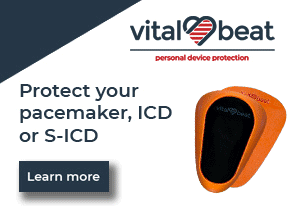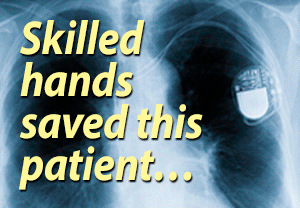 Atrial Flutter
Atrial Flutter
- by Selwyn
- 2024-02-15 12:48:45
- Surgery & Recovery
- 521 views
- 9 comments
After 2 months of atrial flutter, I saw the cardiologist yesterday and am having my fourth ablastion this MondaY. THANK YOU NHS.( 4 days wait). Bloods and swabs etc. taken for a general anaesthetic in out patients.
I have had a flutter ablation previously on rhe right side. I have had two fibrillation ablations.
What did I learn?
Atypical flutter - this time in the left atrium. Why? residual effect of the two fibrillation ablations. Still some electrical activity in the atrium that is spurious.
How to tell if atypical flutter? The down stroke of the P wave ( of the saw tooth base line of flutter) is more acute.
I was offered:
1. Do nothing ( didn't fancy the long term asynchony and possible heart failure)
2. Take sotolol ( I cannot exercise on beta blockers).
3. Take amiodarone ( such a toxic drug, and then the problem is for how long, and it will not produce a long term 'cure')
4. Have an electrical cardioversion - again likely to be a termorary fix.
5. Accept the complications of an ablation.
There is nothing you can do in life without complications. It will be nice to have improved quality of life with regard to my ability to exercise.
I am really grateful for the service I receive from Liverpool Heart and Chest Hospital on the NHS. I have an overnight stay for monitoring/bleeding. I always go into hospital with ear plugs! I hope to find a good read on my e-reader.
9 Comments
Atypical flutter
by Julros - 2024-02-15 13:59:17
I had an atypical flutter ablation last March, and so far, it is lasting. this apparently was quickliy isolated and zapped. I also had a radiofrequency a fib ablation that took quite a bit longer. I had a typical a flutter ablation 4 years ago.
I continue to take Toprol and sotalol, to suppress NSVT. I felt so much better after the last ablation. Yeah, perhaps I have decreased speed and endurance while jogging, but I still enjoy it. I have an ebike so I can do hills.
Best wishes and an uneventful recovery! I was prescribed omeprozole post procedure due to prolonged delivery of RF energy. And I had a bit of chest pain for 5 days.
Verrrry interesting!
by Lavender - 2024-02-15 18:18:22
It was cool to watch the way your mind works in assessing the problem and listing pros and cons to come to a decision! Such a wise man! Having a medical degree as you do comes in handy! May all go smoothly! Peace!
Ablation for atrial arrhythmias
by Selwyn - 2024-02-15 18:20:58
One of the reasons for the acute admission is to get to me whilst the arrhythmia is active.
If I remember rightly, Gemita, it takes a couple of hours to do a flutter ablation. Flutter is due to a circular rhythm, usually around the tricuspid ( ie. right side of heart) valve. My original flutter ablation was done on the right side, 11 years ago, and is still good. So, Julros, the outcome remains very good. My consultant says they are better at doing these than 10 years ago. There is state of the art software - the hospital is trialing Ripple Mapping software ( for the technical minder and the curious see: https://www.ncbi.nlm.nih.gov/pmc/articles/PMC5089464/
You will see from the information I have referred you to that the software builds up a 3-D image of the electrical activity of your heart chambers. Such clever stuff. You need markers over your chest and a central reference point. I wonder if they use a red sticker!
Thank you all for your best wishes.
I never realised you could get atrial fibrillation in the left atrium. This seems to be related to scar tissue from the atrial fibrillation ablation (s) [two in my case].
If you want to understand the mechanism, may I suggest you read:
https://www.ncbi.nlm.nih.gov/books/NBK540985/
There is always more to learn. No doubt the electro-cardiologists enjoy this developing area of cardiology.
Sounds promising
by Gemita - 2024-02-16 04:48:04
Thank you for the feedback Selwyn. Ripple Mapping I see allows for the precise identification of the Atrial Tachycardia substrate in a “scarred atrium”, thus identifying the tachycardia's true mechanism and optimal ablation site, without the need for an experienced computer-operating assistant. Sounds really promising and I will know what to ask about should my intermittent Flutter progress.
I am keeping my fingers crossed for you. I see you will be put to sleep so you won't be following the procedure, but wouldn't it be interesting if we could?
https://www.ncbi.nlm.nih.gov/pmc/articles/PMC6304800/
Sounds Promising
by Selwyn - 2024-02-16 12:20:46
Thanks for the paper about Ripple Mapping Gemita.
It is co-authored by my consultant (Dr Luther), so I expect I am in very good hands.
The lady who deals with my pacemaker settings ( Susan Hughes), also co-writes about Ripple Mapping- a wonderful treatment for venticular tachycardias.
https://onlinelibrary.wiley.com/doi/10.1111/jce.15766
Thank goodness we have such centres of excellence locally.
Atrial flutter ablation.. My 4th ablation.
by Selwyn - 2024-02-22 10:43:49
Well, three and a half hours later, my heart was back in sinus rhythm having had a general anaesthetic, and I only had 5 hours to lay flat on my back post operatively. I can't say hospital ceilings are interesting.
I had a transoesophageal echocardiogram to exclude clot in the atria.
Thanks to the skill of my cardiologist, he eventually managed to get a catheter in my coronary sinus. Using CARTO navigation and an Octaray catheter ( https://www.jnjmedtech.com/en-US/product/octaray-mapping-catheter-trueref-technology) he found my right atrium was being activated from my left! My intra-atrial septum was perforated to give access to the left atrium. They then were able to map-zapped one area of activation in the left atrium , and then noted another area to zapp. As soon as the second area was zapped, the arrythmia settled. Burst pacing confirmed this is now not a problem.
Unfortunately, it seems I have an area of scarring in my left atrium of unknown cause. There is a likelihood of having another area fire off to cause the same problem.
I can't drive for 2 days. I have a right groin bruise. ( access via the femoral vein) and a bit of soreness. It looks like a giant octapus has attacked me as I am allergic to the glue used in adhesive pads.
I am in sinus rhythm when not being paced. Hurray! I am told that I can get back to exercise in a week or two.
I am very grateful to Liverpool Heart and Chest Hospital for their expertise and care.
Although there is a lot of criticism of the National Health Service, I was seen in outpatients after a two week wait, and within 5 days had had my surgery. We can all be critical - I find NHS decaf. tea tasteless, but in the great scheme of things, the NHS has been so good, and at no financial cost my friends from over the pond, please note.
So relieved to hear from you
by Gemita - 2024-02-22 12:05:59
Dear Selwyn, thank you so much for that detailed report. It was a relief to hear from you and to know that everything has gone well. I do understand it is early days and that you can expect a period of healing when you might experience episodes of arrhythmia, but hopefully not long lasting.
To be back in NSR must be such a relief and I hope it lasts and that the scarring in your left atrium of unknown cause will not be a trigger for further Flutter episodes in the future. I know you had AF, so perhaps the scarring comes from that or from your previous AF Ablation? I hope one rhythm disturbance won’t unmask another any time soon.
How long does it take the intra atrial septum perforation to heal Selwyn and is it likely to cause any difficulties? I know about the groin bruising only too well from my EP Study when I developed a Pseudo-aneurysm. I had to stay in hospital for 4-5 days and was taken off Edoxaban. My leg looked a mess. They found during the Study I was in AF with very rapid fractionated signals in the DCS>PCS. The Right Atrium was relatively organised.
Take care Selwyn and I hope you recover quickly and can return to your activities in a short while. I am so glad it is behind you
Iatrogenic ( Doctor produced) atrial septal defect [ iASD ]
by Selwyn - 2024-02-27 10:31:03
https://pubmed.ncbi.nlm.nih.gov/24118262/
and https://pubmed.ncbi.nlm.nih.gov/21545526/
https://pubmed.ncbi.nlm.nih.gov/21248245/
Hello Gemita,
In answer to your question:
Eighty-seven percent of patients had an iASD immediately after the procedure, the majority of which sealed by 6 months (incidence of iASD, 34% at 45 days, 11% at 6 months, 7% at 12 months). Whereas the majority of iASDs were <3 mm in diameter immediately after the procedure, the minority of iASD were >3 mm during the follow-up period.
Up to 1 in 5 patients had a atrial septal defect 1 year after the procedure one study found.
Immediate postprocedural incidence of iASD was as high as 87%, with decreased incidence of residual iASD detected over time. At 18 months of follow-up, up to 15% of iASD cases persisted. Residual iASDs were not associated with clinical sequelae of embolism, cyanosis, or right heart failure
Transseptal catheterization procedures with a large-diameter transseptal sheath have a high spontaneous closure rate of iASDs that is not associated with an increased rate of stroke/systemic embolization during long-term follow-up.
My understanding is that as time has gone on the needle producing the hole has been changed for a radioablation fine catheter, and this is both quicker and results in a small hole which therefore will heal quickly.
As this is the third procedure I have had via the intra-atrial septum, I think I either must be blessed or just plain 'Holy.'
You know you're wired when...
Microwave ovens make you spark.
Member Quotes
I can honestly say that I am feeling absolutely amazing!


.png)


Allow proper time for healing
by Gemita - 2024-02-15 13:48:02
That is very fast Selwyn!
I am glad you have been offered a potentially curative procedure for your atypical Flutter. You couldn’t have chosen better. Medication and cardioversion aren’t likely to give you the potential success of an ablation and neither cardioversion nor meds like Sotalol and Amiodarone are entirely without risk. In your shoes I would be going for the ablation too.
Do you know how long the procedure is likely to take? Could this take hours or do they know from earlier EP studies exactly where they need to ablate although you are in Flutter now, so they will see from where it originates, unless it stops by Monday. I know atypical Flutter is more difficult to fix than typical Flutter but I am hopeful in the right hands you will do well.
I send my very best wishes for a successful fourth ablation next Monday and please don’t return to your activities too quickly. Allow adequate time for healing and please let us know how it goes